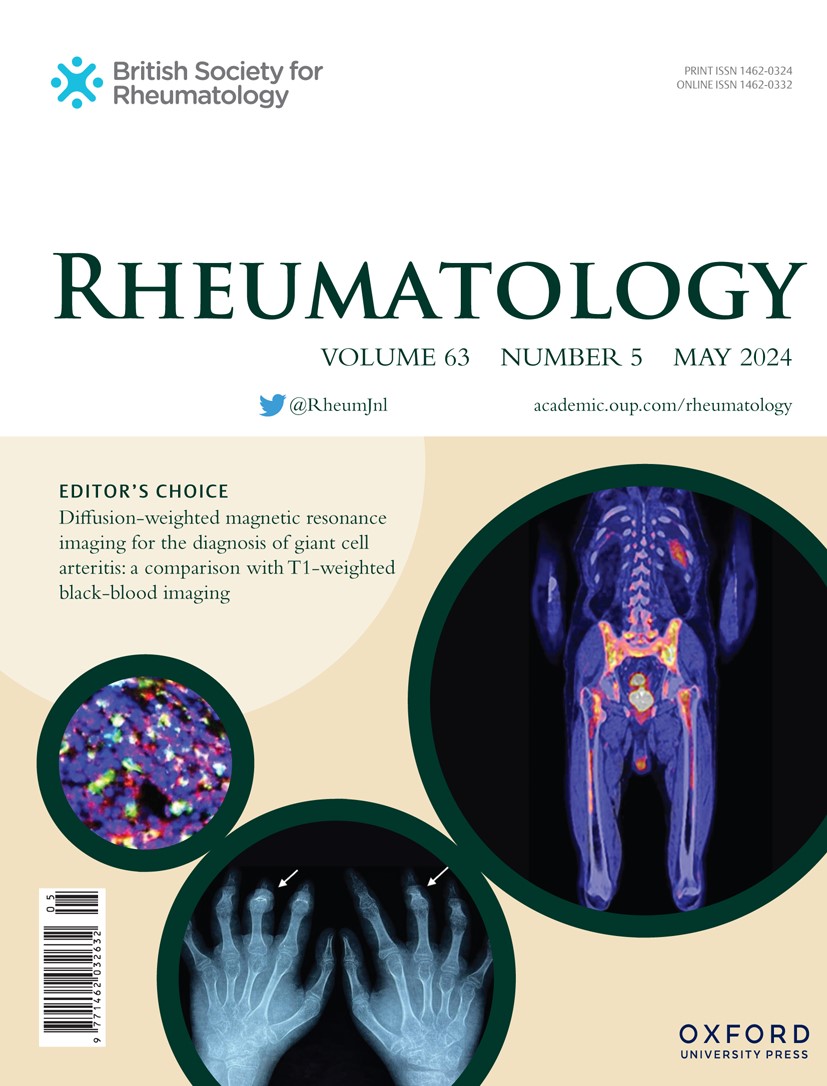在英国生物银行验证QRISK3用于类风湿关节炎心血管疾病风险预测
IF 4.7
2区 医学
Q1 RHEUMATOLOGY
引用次数: 0
摘要
已建立的心血管疾病(CVD)风险预测工具,如QRISK3,已被证明在类风湿关节炎(RA)患者中准确性较低。QRISK3是为普通人群开发的,但研究队列并不总是代表更广泛的公众,这可能解释了其中的一些差异。因此,我们在这里的目的是验证QRISK3在英国生物银行(UKB)中的RA CVD风险预测,这是一项针对普通人群的大规模健康研究。方法使用来自UKB参与者的数据,得出按性别分别计算和验证QRISK3所需的字段。使用自我报告问卷和住院患者数据,相对于初始UKB评估日期确定RA患病率和CVD发病率。普遍的心血管疾病病例,以及服用他汀类药物或缺少汤森剥夺指数数据的参与者被排除在分析之外。其他协变量的缺失数据通过MICE输入,并使用Rubin规则汇总预测的QRISK3概率。QRISK3先前被证明高估了UKB的心血管疾病风险,因此通过估计UKB队列新的10年基线风险来重新校准预测。采用Harrell’s c统计量(判别)和校准图(校准)进行生存分析,验证QRISK3在评估10年心血管疾病风险方面的有效性。412899名受试者符合纳入条件(57%为女性;N = 237,515), RA发病率为4570例(0.01%),CVD发病率为19,552例(0.05%),中位随访时间为10.8年。有358例CVD发病率(约8%),男性和女性RA患者的生存结局明显差于其他队列(log-rank检验p = 6.8x10-20和p = 5.2x10-19)。RA亚组在各种临床CVD危险因素上也存在显著差异,包括BMI (p = 5.7x10−22)、收缩压(p = 8.2x10−17)和高血压(p = 3.5x10−67)。两组的QRISK3歧视程度适中,具有可比性,男性RA患者的c统计值为0.68,女性RA患者的c统计值为0.69,而其他队列患者的c统计值分别为0.7和0.72。重新校准后,QRISK3的预测在整个队列中显示出很大程度上的准确性。然而,问题仍然存在于RA亚组中,其中预测与观察到的CVD风险不一致,特别是在预测的尾部和年轻女性中。结论:平均而言,UKB参与者比一般人群更健康,因此重新校准对于准确估计模型的预测准确性至关重要。本研究表明,QRISK3对RA患者的校准效果较差;与之前的结果一起,这突出了在RA中使用更新的QRISK版本的需求。重新校准的QRISK3模型为进一步探索英国不同风湿病和肌肉骨骼疾病的CVD风险预测建模提供了基线。斯塔德勒:没有。赵:没有。A. Barton:资助/研究支持;辉瑞、加拉帕戈斯、西弗医药和百时美施贵宝。J. Bowes:没有。本文章由计算机程序翻译,如有差异,请以英文原文为准。
OA37 Validating QRISK3 for cardiovascular disease risk prediction in rheumatoid arthritis in the UK Biobank
Background/Aims Established cardiovascular disease (CVD) risk prediction tools, such as QRISK3, have been shown to be less accurate in patients with rheumatoid arthritis (RA). QRISK3 was developed for use in the general population, but study cohorts are not always representative of the wider public, which may explain some of these discrepancies. Our aim here, therefore, was to validate QRISK3 for RA CVD risk prediction in the UK Biobank (UKB), a large-scale health study of the general population. Methods Data from UKB participants was used to derive the necessary fields to calculate and validate QRISK3 separately per sex. Prevalent RA and incidence cases of CVD were defined relative to the initial UKB assessment date, using self-report questionnaires and hospital inpatient data. Prevalent CVD cases, as well as participants with a prescription for statins or who were missing data for the Townsend deprivation index, were excluded from the analysis. Missing data for other covariates were imputed via MICE, and the predicted QRISK3 probabilities were pooled using Rubin’s rules. QRISK3 has previously been shown to overestimate CVD risk in the UKB, and predictions were therefore re-calibrated by estimating new 10-year baseline hazards for the UKB cohort. Survival analysis was performed to validate QRISK3 in assessing 10-year CVD risk using Harrell’s C-statistic (discrimination) and calibration plots (calibration). Results Data for 412,899 participants was eligible for inclusion (∼57% women; N = 237,515), with 4570 prevalent cases of RA (0.01%) and 19,552 incidence cases of CVD (0.05%), over a median follow-up time of 10.8 years. With 358 incidence cases of CVD (∼8%), men and women with RA had significantly worse survival outcomes than the rest of the cohort (log-rank test p = 6.8x10-20 and p = 5.2x10-19, respectively). The RA subgroup additionally differed significantly across a variety of clinical CVD risk factors, including BMI (p = 5.7x10−22), systolic blood pressure (p = 8.2x10−17), and hypertension (p = 3.5x10−67). QRISK3 discrimination was modest and comparable across the two groups, with C-statistics of 0.68 for men, and 0.69 for women with RA, compared to 0.7 and 0.72 for the rest of the cohort. After re-calibration, QRISK3’s predictions are shown to be largely accurate across the cohort. However, issues persist in the RA subgroup, where predictions did not align with observed CVD risk, particularly at the tail end of predictions and in young women. Conclusion UKB participants are on average healthier than the general population, and re-calibration is therefore essential for accurately estimating a model’s predictive accuracy. Here we show that QRISK3 has poor calibration for RA patients; together with previous results this highlights the need for an updated QRISK version for use in RA. The re-calibrated QRISK3 model provides a baseline to further explore prediction modelling of CVD risk across different rheumatic and musculoskeletal diseases in the UKB. Disclosure M. Stadler: None. S. Zhao: None. A. Barton: Grants/research support; Pfizer, Galapagos, Scipher Medicine and Bristol Myers Squibb. J. Bowes: None.
求助全文
通过发布文献求助,成功后即可免费获取论文全文。
去求助
来源期刊

Rheumatology
医学-风湿病学
CiteScore
9.40
自引率
7.30%
发文量
1091
审稿时长
2 months
期刊介绍:
Rheumatology strives to support research and discovery by publishing the highest quality original scientific papers with a focus on basic, clinical and translational research. The journal’s subject areas cover a wide range of paediatric and adult rheumatological conditions from an international perspective. It is an official journal of the British Society for Rheumatology, published by Oxford University Press.
Rheumatology publishes original articles, reviews, editorials, guidelines, concise reports, meta-analyses, original case reports, clinical vignettes, letters and matters arising from published material. The journal takes pride in serving the global rheumatology community, with a focus on high societal impact in the form of podcasts, videos and extended social media presence, and utilizing metrics such as Altmetric. Keep up to date by following the journal on Twitter @RheumJnl.
 求助内容:
求助内容: 应助结果提醒方式:
应助结果提醒方式:


